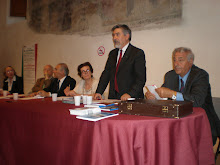sabato 31 maggio 2014
Have the three arrows of Abenomics hit their targets?
The eponymous economic agenda championed by the prime minister, Shinzo Abe, known as "Abenomics"—which aims to reflate and put the economy onto a high growth trajectory—continues to have a generally positive impact on Japan's economy, but the government's commitment to forcing through its most controversial measures will be tested in 2014. Failure on this front will have a profound effect on Japan's long-term growth trajectory. The Economist Intelligence Unit expects the economy to remain on a sustainable growth path over the short term, but rates of GDP expansion will remain unimpressive.
The initial, more straightforward stages of Abenomics have been implemented and have broadly achieved what was intended. Mr Abe's platform consists of three strands, or "arrows": flexible fiscal policy, aggressive monetary loosening and deregulation. The first two of these arrows gained traction in 2013, when a weak yen boosted the value of exports (in local-currency terms) and contributed to an acceleration in the rate of consumer price inflation, to an average of 1.2% year on year in July–December, the fastest pace for five years. Real interest rates also entered negative territory for the first time in years. But the third arrow of Mr Abe's programme, structural reform, has yet to gain traction.
How aggressively Mr Abe pursues structural reform remains one of the central questions for 2014. Certainly, there is a temptation instead to bask in the glory of battles already won. There have been two fiscal stimulus packages in the past year or so, and monetary policy has undergone dramatic change after the Bank of Japan (BOJ, the central bank) adopted a new framework, referred to as "quantitative and qualitative monetary easing", in April 2013, a variant of quantitative easing.
Hitting the target
The marked depreciation of the yen, which averaged ¥97.6:US$1 in 2013, compared with ¥79.8:US$1 in 2012, has helped to support economic growth and push up price growth towards the BOJ's core consumer price inflation target of 2%. Average monthly trade data for January–February 2014 showed a 9.6% year-on-year rise in exports in local-currency terms. The rate of consumer price inflation has been accelerating in recent months and stood at 1.5% in February. Much of Japan's inflation is still of the "wrong sort", driven by cost-push pressures such as the high cost of imported fuel (a problem aggravated by the shutdown of all of Japan's nuclear reactors), rather than by demand-pull factors, which would indicate a more fundamental break with the entrenched deflation of the past.
Inflation will be boosted by the 3–percentage-point increase in the rate of consumption tax, to 8%, that took effect in April. We expect the tax rise to lift average inflation to 2.9% in the second quarter and to 2.3% for 2014 as a whole, which would be the fastest annual rate since 1991. Our forecast of inflation of 1.6% on average in 2015 already accounts for a second planned rise in the consumption tax rate, to 10%, in October of that year. The government is not committed to this second increase—Mr Abe has said that it is dependent on further satisfactory economic growth—but to step away from the policy because of a weak economy would cast the entire Abenomics project in a poor light. As a result, we expect the rise to be implemented.
Structural reform doubts
If the first two arrows have hit their respective targets, the trajectory of the third is still to be determined. Deregulation offers ample scope to boost Japan's natural rate of GDP growth. The government has expressed a desire to liberalise the electricity and pharmaceutical industries, to reform the social security system, and to get more women into the workplace and into senior positions. So far, progress on these and other reforms has been slow and resistance among vested interests, many of whom belong to Mr Abe's Liberal Democratic Party, has been fierce.
Although the creation of special economic zones and some cuts to corporate taxes are likely, they do not represent the sort of dramatic changes that are needed to put the economy on a high-growth trajectory. Mr Abe has had some success in his attempt to use trade agreements as a method to coerce Japan's cosseted farmers, in particular, to become more competitive. In April a deal was signed with Australia that will see high tariffs on agricultural goods imports fall over the next 15 years, putting greater pressure on the domestic sector. However, the failure of US and Japanese trade officials to agree agricultural and automotive tariffs is holding up trade negotiations for the 12-member Trans-Pacific Partnership, the conclusion of which will help to create a huge free-trade area that would cover nearly one-third of world exports.
Subdued growth
Just as doubts are rising over whether Mr Abe's economic agenda will put the economy on a higher long-term growth trajectory, concerns are increasing over near-term prospects for expansion following the increase in the consumption tax rate in April. Similar to other forecasters, we believe that the tax rise will make economic growth volatile this year and expect it to cause a quarter-on-quarter contraction in the economy in April–June. However, the ongoing implementation of the budget for fiscal year 2014/15 (April–March) and a ¥5.5trn (US$53.6bn) supplementary stimulus package will boost economic activity in the second half of this year, resulting in real GDP growth of 1.5% for the year as a whole.
Abenomics has played a key role in reflating Japan's economy, which had been trapped in a deflationary bind for nearly two decades, but until structural reforms gain significant traction, rates of economic growth will remain unimpressive—at an annual average of 1.3% in 2015–18—as negative trends such as rising public debt, lingering overcapacity and the ageing of the population take their toll.
Iscriviti a:
Commenti sul post (Atom)










Nessun commento:
Posta un commento